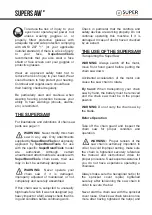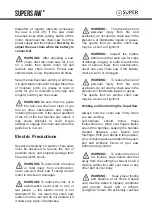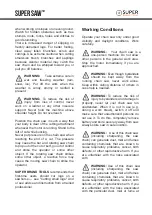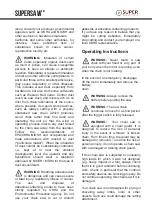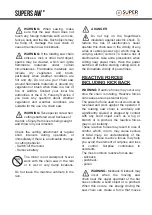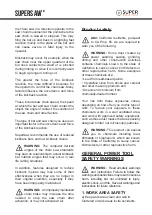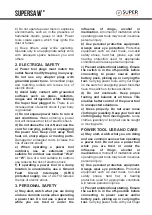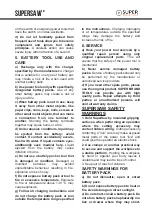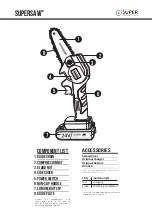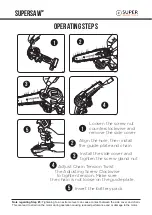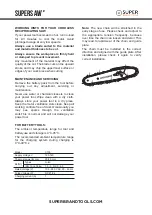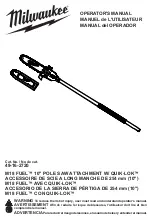
b) Do not operate power tools in explosive
environments, such as in the presence of
flammable liquids, gases or dust. Power
tools create sparks which may ignite the
dust or fumes.
c) Keep others away while operating.
Operate only in an appropriate safety zone
with adequate space between you and
others.
2. ELECTRICAL SAFETY
a) Power tool plugs must match the
outlet. Never modify the plug in any way.
Do not use any adapter plugs with
grounded power tools.
Unmodified plugs
and matching outlets will reduce risk of
electric shock.
b) Avoid body contact with grounded
surfaces such as pipes, radiators,
ranges and refrigerators while holding
the Super Saw plugged in.
There is an
increased risk of electric shock if your body
is grounded.
c) Do not expose power tools to rain or
wet conditions.
Water entering a power
tool will increase the risk of electric shock.
d) Do not abuse the cord. Never use the
cord for carrying, pulling or unplugging
the power tool. Keep cord away from
heat, oil, sharp edges or moving parts.
Damaged or entangled cords increase the
risk of electric shock
e) When operating a power tool
outdoors, use an extension cord
suitable for outdoor use marked “W-A”
or “W”.
Use of a cord suitable for outdoor
use reduces the risk of electric shock.
f) If operating a power tool in a damp
location is unavoidable, use a Ground
Fault Circuit Interrupter (GFCI)
protected supply.
Use of a GFCI reduces
the risk of electric shock.
3. PERSONAL SAFETY
a) Stay alert, watch what you are doing
and use common sense when operating
a power tool. Do not use a power tool
while you are tired or under the
influence of drugs, alcohol or
medication.
A moment of inattention while
operating power tools may result in serious
personal injury.
b) Use personal protective equipment.
Always wear eye protection.
Protective
equipment such as dust mask, non-skid
safety shoes, hard hat, gloves, eye and
hearing protection used for appropriate
conditions will reduce personal injuries.
c) Prevent unintentional starting. Ensure
the switch is in the off-position before
connecting to power source and/or
battery pack, picking up or carrying the
tool.
Carrying power tools with your finger
on the switch or energising power tools that
have the switch on invites accidents
d) Do not overreach. Keep proper
footing and balance at all times. This
enables better control of the power tool
in unexpected situations.
e) Dress properly. Do not wear loose
clothing or jewellery. Keep your hair and
clothing away from moving parts.
Loose
clothes, jewellery or long hair can be caught
in moving parts
POWER TOOL USE AND CARE
a) Stay alert, watch what you are doing
and use common sense when operating
a power tool. Do not use a power tool
while you are tired or under the
influence of drugs, alcohol or
medication.
A moment of inattention while
operating power tools may result in serious
personal injury.
b) Use personal protective equipment.
Always wear eye protection.
Protective
equipment such as dust mask, non-skid
safety shoes, hard hat, or hearing
protection used for appropriate conditions
will reduce personal injuries.
c) Prevent unintentional starting. Ensure
the switch is in the off-position before
connecting to power source and/or
battery pack, picking up or carrying the
tool.
Carrying power tools with your finger
SUPERSAW
TM


